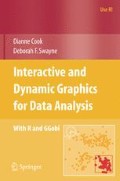The aim of unsupervised classification, or cluster analysis, is to organize observations into similar groups. Cluster analysis is a commonly used, appealing, and conceptually intuitive, statistical method. Some of its uses include market segmentation, where customers are grouped into clusters with similar attributes for targeted marketing; gene expression analysis, where genes with similar expression patterns are grouped together; and the creation of taxonomies of animals, insects, or plants. A cluster analysis results in a simplification of a dataset for two reasons: first, because the dataset can be summarized by a description of each cluster, and second, because each cluster, which is now relatively homogeneous, can be analyzed separately. Thus, it can be used to effectively reduce the size of massive amounts of data.
Access this chapter
Tax calculation will be finalised at checkout
Purchases are for personal use only
Preview
Unable to display preview. Download preview PDF.
Rights and permissions
Copyright information
© 2007 Springer Science+Business Media, LLC
About this chapter
Cite this chapter
(2007). Cluster Analysis. In: Interactive and Dynamic Graphics for Data Analysis. Use R!. Springer, New York, NY. https://doi.org/10.1007/978-0-387-71762-3_5
Download citation
DOI: https://doi.org/10.1007/978-0-387-71762-3_5
Publisher Name: Springer, New York, NY
Print ISBN: 978-0-387-71761-6
Online ISBN: 978-0-387-71762-3
eBook Packages: Mathematics and StatisticsMathematics and Statistics (R0)

